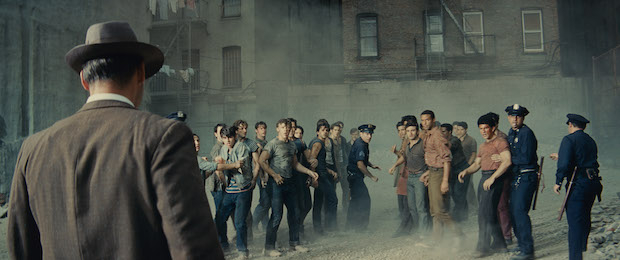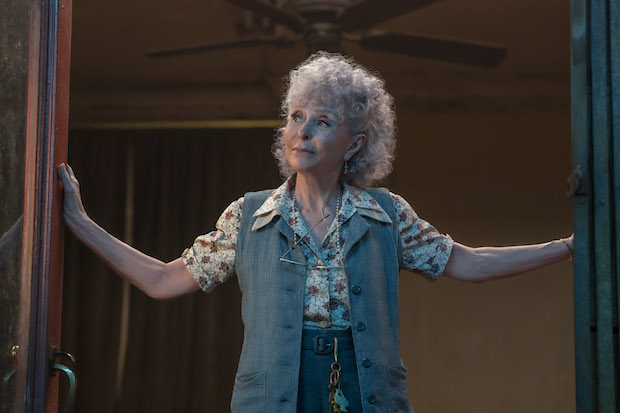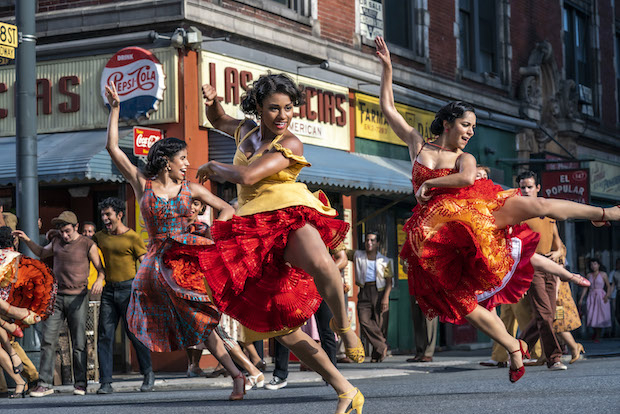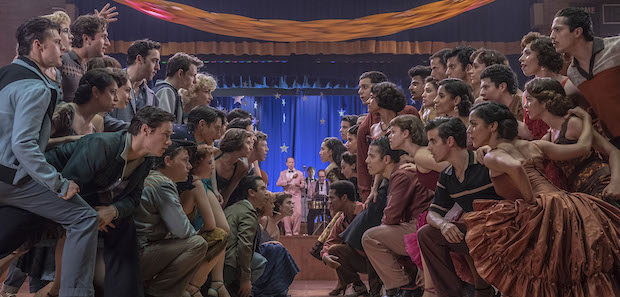Review: Steven Spielberg's West Side Story Is Better Than the Original
The remake of the iconic American musical takes big risks, and they pay off.

(© 20th Century Studios)
The opening shot of Steven Spielberg's remake of West Side Story for 20th Century Studios shows the wreckage of Manhattan's San Juan Hill neighborhood, a wasteland of demolished brownstones and bathtubs as desolate as anything in Saving Private Ryan. Named for the crucial battle of the war that brough Puerto Rico into our empire (and thereby facilitated the migration of Puerto Ricans to the Empire state), San Juan Hill's most notable feature today is the Lincoln Center, that acropolis of the arts where Leonard Bernstein conducted, home of the Jerome Robbins Dance Division, and site of Stephen Sondheim tributes past, present, and future.
It is clear from the beginning that the Sharks and Jets, the rival gangs feuding over this turf, are like polar bears mauling one another on a melting glacier. And it is with the foresight of a 21st-century screenwriter that Lieutenant Schrank (a gruff Corey Stoll) tells the Jets, those "last of the can't-make-it Caucasians," that this slum is destined to be replaced by a playground for the ultra-wealthy, whose Puerto Rican doormen will keep the likes of them at a safe distance. Leave it to Tony Kushner to turn Romeo & Juliet into a story about gentrification and the left-behind whites whose resentment fuels so much of our politics.
And yet in adding these new layers to an old story, Kushner (Pulitzer Prize winner for Angels in America and Spielberg's collaborator on Munich and Lincoln) has sacrificed none of the high drama, raw passion, and sweeping musicality that has embedded West Side Story in the American imagination since its 1957 Broadway debut.

(© 2020 Twentieth Century Fox Film Corporation)
With music by Bernstein, lyrics by Sondheim, and original book by Arthur Laurents (adapted here by Kushner), West Side Story tells the story of Tony (Ansel Elgort) and Maria (Rachel Zegler), two young people who fall in love at a school dance suddenly and quite irrationally (as all the best love affairs begin). Maria's brother, Bernardo (a commanding David Alvarez), leads the Sharks, the local Puerto Rican gang. Trying to turn over a new leaf, Tony feels a residual allegiance to the Jets, the white gang whose leader, Riff (Mike Faist, pure rage hiding behind a coy smile), despises the Puerto Ricans and the changes they have brought to his childhood neighborhood. As the two tribes prepare for battle, Tony and Maria wonder if there is a place for them.
Elgort and Zegler easily sell this story of love at first sight. Incredibly attractive and percolating with chemistry whenever they're onscreen, they remind us what it is like to be young and in love (even if we, like the bystanders in the suddenly comical number "Maria," roll our eyes at this most human of conditions).

(© Twentieth Century Fox Film Corporation)
Several of the supporting roles pull us into the depths of the story too: Tough and loyal as a Rottweiler, Iris Menas shows us that people like Anybodys have always existed. Innocent and dorky as Chino, Josh Andrés Rivera carries on his hunched shoulders the heavy expectations of an immigrant community looking to advance. Ariana DeBose is powerful, sexy, and practically unstoppable as Anita. And Rita Moreno (who won an Oscar for playing Anita in the 1961 film) steals our hearts in the new role of Valentina, delivering a heartbreaking rendition of "Somewhere."
So much of the power of West Side Story is in Bernstein's music, and it sounds glorious under the baton of his spiritual heir, Gustavo Dudamel. Playing off the symphonic drama of the music, vocal producer Jeanine Tesori has led the cast to simple yet emotionally powerful renditions of these well-known songs, telling the story of regular people caught in the riptide of circumstance.

(© Twentieth Century Fox Film Corporation)
Justin Peck's new choreography liberates the material from the iron clutches of original director-choreographer (and all-around egomaniac) Jerome Robbins. Peck knows when to hold onto what works, but he knows when to branch out and try something new, resulting in dances that mambo across the border between sexy and dangerous. He collaborates particularly well with costume designer Paul Tazewell: I was mesmerized by the swoosh of Anita's yellow dress and red underskirt as DeBose flew across the screen during "America."
In his musical debut, Spielberg has created a masterpiece. Like Busby Berkeley, he makes sure we always have the best view of the action. His attention to detail rivals that of Vincente Minnelli. And like any good director, he knows how to hire the right people: Huge credit should go to director of photography Janusz Kaminski, production designer Adam Stockhausen, and a team of art directors and designers who surely must have access to a time machine. Every shot is like an old color photograph brought to life.

(© Niko Tavernise / 20th Century Studios)
I will not engage in a shot-by-shot comparison of this West Side Story and Robbins's 1961 film. There is no shortage of curmudgeons chomping at the bit to do that dismal work. But I will say that given a choice between the two, I would pick this new West Side Story, hands down. Spielberg and Kushner have shown that a property like West Side Story has strong enough bones to support a renovation that speaks directly to today, but that this process need not result in the didacticism of the charmless Broadway revival.
And speaking of fresh looks, we owe one to America's greatest living filmmaker, the celluloid populist we all think we know: Had Spielberg started his career in another age, when movie-musicals were still in fashion, one suspects that he would have helmed America's best musicals rather than its best action-adventure films. And now that he's at a point in his career where he can pretty much do whatever he wants, maybe he will. I sure hope so.








